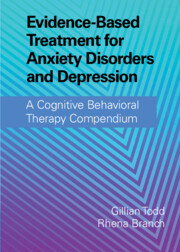 Evidence-Based Treatment for Anxiety Disorders and Depression
Evidence-Based Treatment for Anxiety Disorders and Depression from Part One - Cognitive Behavioral Therapy for Anxiety Disorders
Published online by Cambridge University Press: 06 January 2022
Panic disorder is an anxiety disorder where people experience recurrent, unexpected panic attacks. The evidence-based CBT model of panic disorder developed by Clark still remains the dominant treatment for this disorder. This chapter explores some of the theory around panic disorder, looking at the underlying mechanisms that maintain this disorder. It will also provide guidance on assessment and formulation. Evidence-based treatment techniques are presented and direction on how to implement these, as well as strategies to prevent future relapse.
To save this book to your Kindle, first ensure [email protected] is added to your Approved Personal Document E-mail List under your Personal Document Settings on the Manage Your Content and Devices page of your Amazon account. Then enter the ‘name’ part of your Kindle email address below. Find out more about saving to your Kindle.
Note you can select to save to either the @free.kindle.com or @kindle.com variations. ‘@free.kindle.com’ emails are free but can only be saved to your device when it is connected to wi-fi. ‘@kindle.com’ emails can be delivered even when you are not connected to wi-fi, but note that service fees apply.
Find out more about the Kindle Personal Document Service.
To save content items to your account, please confirm that you agree to abide by our usage policies. If this is the first time you use this feature, you will be asked to authorise Cambridge Core to connect with your account. Find out more about saving content to Dropbox.
To save content items to your account, please confirm that you agree to abide by our usage policies. If this is the first time you use this feature, you will be asked to authorise Cambridge Core to connect with your account. Find out more about saving content to Google Drive.